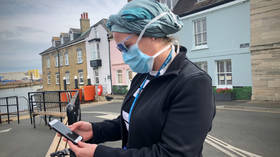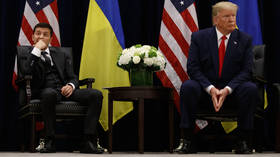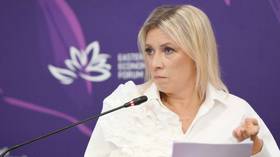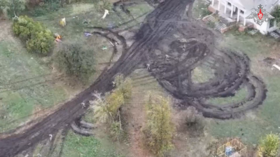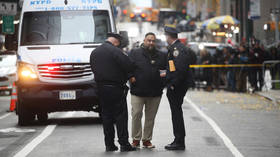‘A slow and botched response’: My eight weeks on the Covid-19 frontline have taught me how the NHS made this crisis worse
No PPE, no tests, no support. I work as a GP in care homes and a hospital setting, and watched in horror over the past few weeks as the approach we took to tackling the virus caused my elderly patients to die.
As with most people, Covid-19 seemed a long way away to me in January. I was working as a GP in out-of-hours cover, and in Intermediate Care. This means rehabilitating elderly people following accidents or illness, who need support and medical attention before going home.
All was calm at the start of the year. Yes, China was going into lockdown, a few people had become trapped on cruise liners, posting interminable online videos. Would Covid come here, to the UK? The NHS was untroubled, slumbering.
Also on rt.com ‘Our NHS, hallowed be thy name’ – Brits need to see health service for bloated bureaucracy it is and reform it nowI went skiing in France, the Grand Massif, in the first week in March, when Covid still seemed a distant thing, unlikely to change my work, or my life. I suppose it was like sitting on a mountain, being told that a bank of snow was forming that might eventually form an avalanche and head my way. But when I looked out of the window, the sun was shining, the sky was blue. Nothing to see.
No-one I knew had Covid, nothing much was going on. I had seen no patients with the disease, but in early March the avalanche was striking Italy, and the sky above was darkening. Was it really coming here? I watched Liverpool getting knocked out of the Champions League by Atletico Madrid. Then Spain locked down. Then…
Then the cases in the UK started to rise. Suddenly, this was getting serious. What exactly was this disease? Was it like the flu, was it something else? As the avalanche began to rumble, hospital managers began charging about at high speed, bumping into each other and bellowing instructions – often directly contradictory. We had bronze meetings, then silver and gold meetings. The clipboards were all out.
Almost instantly, things had gone from placid to panic, panic, panic. On the TV news, we could see that hospitals were getting overwhelmed in Italy. The elderly were lying, dying, in corridors. Ventilators, we need ventilators. We need more capacity in the hospitals, we need beds. Like a slumbering beast, the NHS had awoken. More than a bit late.
Money started to get thrown around – as if money could suddenly make more beds, or more staff, or create new nursing homes – or open those that had been shut. The bullying began. Of course, it wasn’t called bullying, but hospitals needed to be cleared out and nothing and no-one was going to get in the way. Edicts were handed down, orders barked.
In our little world, we were commanded to discharge our hospital patients as quickly as possible, to send them back to their families or their care homes. The two nursing homes where I look after patients started to fill up with new patients from hospital, often Covid-19 positive. Staff had no PPE; barrier nursing was impossible. Early warning signs. I made my concerns about this clear.
Essentially, there was a single objective for the NHS. Get the hospitals clear of patients. We absolutely had to have capacity. Social workers were told to find beds for patients in the community, no objections were allowed. Then lockdown happened, staff were going off sick all over the place, because someone in their household had symptoms of Covid-19.
Also on rt.com Heroic failure: Why did the NHS keep building NINE Covid-19 emergency hospitals even when it was clear there was no need for them?However, if a member of staff developed symptoms – everyone else had to stay at work. Because… a virus at home was obviously completely different to a virus at work. At this time there was no swabbing, no testing, so no-one knew who was infected, and who was not.
This was when we all became aware that expediency, and targets, were clearly overwhelming any safety concerns. Staff had little, or no, protection. The PPE that was deemed to be necessary – was whatever PPE was actually available. The guidance could change three times a day.
All of a sudden, in early April, the elderly patients I was looking after started to die. One day, here were no cases, then, 24-hours later, we had many. The deaths were strange, quick. One nurse watched four patients develop exactly the same symptoms. A fall, then strange lapses of consciousness, then their breathing rate going up and their oxygen levels falling. The patients were remarkably calm, not distressed. Then they died. Two before ambulances could even get there.
More staff started to get symptoms, patients were getting symptoms, still no-one could get a test. The only people being tested were those, very ill, arriving at hospital. Why? What did it matter if they had Covid or not? They were ill, they needed the correct treatment for their symptoms.
What difference would it make if they had a diagnosis of Covid-19? It was the managers that needed to know. It seemed that research statistics were more important than protecting the staff. We really needed to know.
Early April and the local hospital was now, virtually empty, wards lying silent, elective surgery halted, cancer treatment stopped. By mid-April, the emergency Nightingale hospitals were also empty. Well, the primary objective had certainly been met. The hospitals were clear.
All this time, our care home beds were being filled up with Covid-positive patients (many having been discharged or turned away from hospitals), and patients who had not been tested, but could be infected. Here we were, with the elderly vulnerable, in our care. The absolutely most at-risk population. Piling them in. Every time I coughed, I wondered, have I got it? I started popping an oxygen monitor onto my finger on a regular basis. Was it dropping? What’s my temperature? What’s my pulse rate… luckily, nothing changed.
In out-of-hours care at the hospital, things had become very strange. Across the corridor, A&E staff were twiddling their thumbs. The number of patients arriving to see a doctor had fallen through the floor. Pods were created to see those patients who did arrive. Pod being a fancy name for a portacabin with a non-closing door. What was our PPE? A surgical mask, non-fitted, gloves that split, and an almost immediately disintegrating plastic pinny.
Also on rt.com Health officials ‘withholding evidence’ on why UK did not follow South Korea’s successful Covid-19 strategy – UK science chairBut yes, this was all that was required, according to Public Health England. Until better PPE arrived, then suddenly that was what we required instead. Then it ran out, and we didn’t need better PPE anymore. Back to the disintegrating pinnies.
In the nursing homes and in Intermediate Care, my objections to filling up beds with Covid-positive patients was beginning to have some effect. Rather too late. Our rehab unit has beds for thirty patients; ten were Covid-positive. Eight died, and seven staff were tested positive. On the plus side, moves were being made to clear the unit, to turn it green, free from Covid-19.
Then came the problem of death certification. What should I write? Covid, or not Covid? Who knew, because still no-one was being tested in nursing homes. Not patients, not staff. Pure guesswork. By this point, even the national news was recognising that Care Homes were the new front line of Covid. Further edicts rained down, four or five new protocols a day.
Where are we now? Things are calming down, becoming clearer. The world of panic is rotating more slowly. What went wrong? We all know that, in a crisis, things can go haywire. Things that, in retrospect, look idiotic. Idiotic decisions.
The main thing that went wrong, I believe, was a failure to understand that hospitals would become the vectors for Covid, the epicentres for the infection. We - the hospitals, the decisions taken by the NHS managers with their clipboards - spread the disease, especially among the elderly vulnerable in care homes. A disease that we were trying to stop... killing the elderly and vulnerable.
I believe it is a terrible indictment of our system that it became obsessed by a target. One that ran roughshod over our duty of care for those in our care. The primary rule of medicine is Primum non nocere. Not primum nocere.
Like this story? Share it with a friend!
The statements, views and opinions expressed in this column are solely those of the author and do not necessarily represent those of RT.
